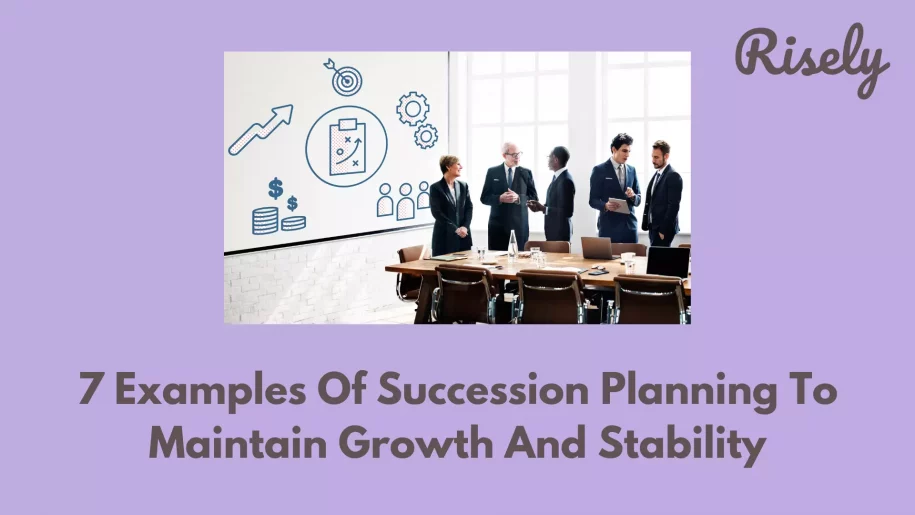7 Examples Of Succession Planning To Maintain Growth And Stability
The uncertainty of the future is something that worries all of us. Especially so when it comes to work. And the only thing we can do for it is to prepare ourselves! Are you prepared for the future of your organization? Have you figured out who will step into leadership roles when the time comes? Well it seems like a difficult choice to make but I will help prepare yourself for it by equipping you with all the knowledge about succession planning. Succession planning ensures a smooth transition into leadership roles. It is something that helps in maintaining stability and ensures that the organization keeps moving towards long-term success. In this blog, you will first go through the meaning and importance of succession planning. You will read about how it impacts an organization and then we’ll take the help of some examples to see how you can safeguard your organization’s future. Let’s explore!Understanding Succession Planning
Succession planning refers to the deliberate and systematic process of identifying, developing, and preparing employees to assume key leadership roles within an organization. It is a strategic approach that ensures a smooth transition of critical positions when they become vacant due to retirement, promotion, or unexpected departures. Succession planning goes beyond simply filling positions; it aims to identify and nurture high-potential individuals to meet future leadership needs. By proactively grooming talent from within the organization, succession planning helps maintain continuity, minimize disruptions, and ensure the long-term sustainability and success of the business.Importance of Succession Planning
Succession planning is of utmost importance as it plays a pivotal role in ensuring a smooth leadership transition for leaders like you, maintaining continuity, and fostering long-term success. Have a look below to know what benefits you could get from right succession planning:- Leadership Continuity: Succession planning helps organizations prepare for inevitable leadership changes, such as retirements, promotions, or unexpected departures. Organizations can ensure a seamless transition by identifying and developing potential successors in advance, minimizing disruptions, and maintaining stability.
- Talent Development: Succession planning catalyzes talent development and employee growth. By identifying high-potential individuals within the organization, organizations can provide them with targeted training, mentoring, and leadership development opportunities. This prepares them for future leadership roles and enhances their skills, engagement, and job satisfaction.
- Knowledge Transfer: Effective succession planning facilitates the transfer of critical knowledge, skills, and expertise from experienced leaders to potential successors. This ensures the preservation of institutional knowledge, promotes learning and reduces the impact of knowledge gaps during leadership transitions.
- Organizational Agility: Succession planning enables organizations to adapt to changing business landscapes. Organizations can adapt quickly, make informed decisions, and capitalize on emerging opportunities by cultivating a pipeline of talented individuals. It also promotes diversity in leadership, bringing fresh perspectives and innovative thinking to the organization.
- Retention and Engagement: Implementing succession planning demonstrates a commitment to employee development and growth. It signals employees that their contributions are recognized and valued, increasing job satisfaction and fostering loyalty. Engaged employees are more likely to stay with the organization, reducing turnover and retaining institutional knowledge.
- Mitigating Risks: Succession planning helps organizations mitigate risks associated with leadership gaps. Organizations can ensure business continuity, maintain stakeholder confidence, and minimize the negative impact of sudden leadership vacancies by identifying and preparing successors in advance.
Other Interesting Reads
5 Examples of Succession Planning
Here are five examples of succession planning initiatives in various roles within an organization: Executive Leadership Succession:- Identifying high-potential employees and grooming them through leadership development programs, mentorship, and exposure to senior leadership.
- Providing opportunities for potential successors to gain experience in different departments and functions to develop a well-rounded skill set.
- Conducting regular performance assessments and assessments of leadership potential to track the progress of potential successors.
- Implementing a mentoring program where experienced managers guide and coach potential successors, sharing knowledge and insights.
- Offering managerial training programs to enhance the skills and capabilities of individuals with potential for future leadership positions.
- Rotating employees through different managerial roles or projects to broaden their experience and prepare them for higher-level responsibilities.
- Identifying employees with exceptional technical skills and providing specialized training and development opportunities.
- Creating a knowledge-sharing culture where experienced technical experts mentor and transfer their expertise to potential successors.
- Encouraging continuous learning and professional development in technical fields through certifications, workshops, and conferences.
- Implementing a structured sales training program to develop potential successors’ sales skills and business acumen.
- Assigning potential successors to work closely with experienced sales professionals to learn from their strategies and techniques.
- Offering opportunities for potential successors to take on increasing sales responsibilities, such as managing key accounts or leading new market initiatives.
- Identifying HR professionals who exhibit leadership potential and providing them with opportunities to work on strategic HR projects or initiatives.
- Offering specialized training in HR management, such as employee relations, talent acquisition, and performance management.
- Developing a talent pipeline within the HR department, nurturing high-performing HR professionals for future HR leadership roles.

Real-life Examples of Succession Planning at Apple and IBM
Succession planning is a critical process for organizations to ensure a smooth transition of leadership roles. We will now take you through two prominent examples of succession planning initiatives: Apple Inc. and IBM. Let’s delve into their real-life examples of succession planning:Apple Inc.
Apple is known for its innovative products and influential leadership. The succession planning at Apple has played a crucial role in maintaining its momentum and continued success. Steve Jobs to Tim Cook: One of the most notable successions in recent corporate history is the transition from Steve Jobs to Tim Cook. As Apple’s co-founder and visionary leader, Steve Jobs had an indelible impact on the company. However, Jobs’s health issues led to the need for a well-prepared successor. In collaboration with Jobs, Apple’s board of directors identified Tim Cook, who had served as the Chief Operating Officer (COO), to take over as CEO. Jobs had groomed and mentored Cook, ensuring a smooth leadership transition. This succession planning strategy showcased the effectiveness of identifying and nurturing internal talent for critical leadership roles. Ongoing Leadership Development: Apple emphasizes continuous leadership development in its succession planning strategy. The company invests in executive coaching, talent assessment, and leadership development programs to identify and develop future leaders from within the organization. By nurturing internal talent, Apple ensures a deep bench of capable leaders who can step into critical roles when needed. This approach aligns with Apple’s culture of innovation and allows for a seamless leadership transition, sustaining the company’s success.IBM
IBM, a renowned technology and consulting corporation, has also implemented successful succession planning strategies throughout its history. Lou Gerstner to Sam Palmisano: In the 1990s, IBM faced significant challenges, and a change in leadership was necessary. As the CEO, Lou Gerstner transformed IBM from a struggling organization to a thriving technology company. When Gerstner stepped down, Sam Palmisano was appointed as his successor. Palmisano held various leadership positions with IBM for over two decades. This internal promotion highlighted IBM’s commitment to developing talent from within the organization and ensuring a smooth leadership transition. Structured Talent Development: IBM’s succession planning focuses on structured talent development and grooming high-potential employees for leadership roles. The company provides comprehensive leadership programs, mentorship opportunities, and exposure to diverse business areas to prepare individuals for future leadership positions. IBM’s leadership development initiatives are designed to identify and cultivate a pipeline of leaders with the skills, knowledge, and expertise needed to drive the company forward. Additionally, IBM emphasizes diversity and inclusion in its succession planning efforts, aiming to develop leaders from diverse backgrounds and perspectives, strengthening the organization’s ability to adapt to a rapidly changing business landscape. These real-life examples of succession planning from Apple and IBM ensure leadership continuity, organizational stability, and sustained success. By identifying and developing internal talent, both companies have seamlessly transitioned leadership roles, maintained competitiveness, and drove innovation in their respective industries.Conclusion
The real-life examples that wehave provided for you highlight the impact of a strategic succession planning. I hope these examples helpedyou in understanding how succession planning fosters talent development, prepares organizations forfuture and also ensures the leadershipcontinuity. Which of these benefits of succession planning have you seenor not seen at workplace? Succession planning is an important area for leaders to invest their time and energy in. Embracing succession planning allows businesses to build resilience, maintain stability, and drive long-term success. So, don’t wait to invest in succession planning for your organization and secure a strong leadership foundation for the future. Start planning today to ensure a seamless transition and create a pathway for continuous growth and success. To better understand the roles and responsibilities of a leader and emerge as a great leader, take assistance from Risely; sign up today!Strengthen your communication skills to build healthier workplaces.
Get your communication skills assessed now to understand hidden mistakes that hold you back.
Other Related Blogs
Know the best sales manager 30 60 90 day plan to be an efficient leader
Know the best sales manager 30 60 90 day plan to be an efficient leader Are you a sales manager looking to make a strong impression on your new team…
Manager Effectiveness: A Complete Guide for Managers in 2024
Manager Effectiveness: A Complete Guide for Managers in 2024 Manager effectiveness is everyone’s favorite buzzword. But the road to achieving it is trickier than it looks like! While manager effectiveness…
5 Steps Training Needs Assessment Model: Why It Is Important For Employees?
5 Steps Training Needs Assessment Model: Why It Is Important For Employees? Have you ever wondered why some training programs hit the bullseye while others miss the mark? Well, it’s…
5 Steps of Developing an Effective Training Evaluation Program: With Best Practices
5 Steps of Developing an Effective Training Evaluation Program: With Best Practices Have you ever wondered how effective those training initiatives truly are? How do you know if they’re making…


